These pictures were taken on June 19th, 2006. This memorial is a great case study
for an attempt to be inclusive while, at the same time, impose a specific patriotic
interpretation on events.

|
The memorial takes a central place on the mall between the Washington
Monument and the other war memorials closer to the Lincoln Memorial.
|

|
It consists of a shallow ramp leading down to a central fountain. On either
side of the fountain is an arc of pylons bearing the names of the 50
U.S. states and several territories. In the center of each arc is a
pavillion, one for the Pacific Theater (the war against Japan),
the other for the Atlantic Theater of war (against Nazi Germany and Italy).
|

|
At the top of the shallow ramp, up on the sidewalk near the street, there is
a flag pole on either side. The bases both bear the same text, leaving
little room for dispute about why the United States fought the war.
|

|
.
|

|
The whole text reads, "Americans came to liberate, not to conquer, to restore
freedom and to end tyranny".
|

|
Here's a view looking down the shallow slope.
|

|
In the center, at the top of the slope, near the sidewalk, this plaque imposes
continuity of purpose on American history and military endeavour.
|

|
The central fountain pool was very tempting on that hot day. The Atlantic
pavillion and one of the arc of state pylons are in the background.
|
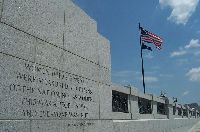
|
This is the view over on the Atlantic side, at the slope, looking up.
|

|
here the view looking down. This view is likely to be where many visitors
start. Along the wall, 12 plaques are visible. They tell a narrative
of the American war effort in the Atlantic Theater.
|

|
Here is the top plaque, the first. The rest are shown in order.
|

|
.
|

|
.
|

|
.
|

|
.
|

|
.
|

|
.
|

|
.
|

|
.
|

|
.
|
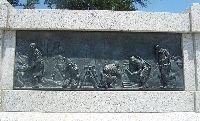
|
.
|

|
The war in Europe ends with the linking of U.S. and Soviet troops in Torgau.
|

|
At the bottom, around the corner, more words adorn the wall.
|

|
This is the centerpiece of the Atlantic side.
|

|
Along the bottom, campaigns are listed. One level higher, the theater is
divided into general areas where Americans fought. Still higher, quotes
inspire the viewer...
|

|
.
|

|
Here are the twelve plaques on the opposite side of the slope/ramp which,
starting at the top, near the sidewalk, tell a story of the war in the
Pacific. The first one apparently shows people hearing the news of the
Japanese attack on Pearl Harbor.
|

|
soldiers being sworn in
|
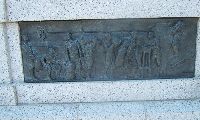
|
.
|

|
.
|

|
.
|

|
.
|

|
.
|

|
.
|
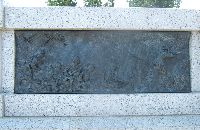
|
.
|

|
.
|

|
.
|

|
...and the war is over.
|

|
Right after the story, a vague quote by Admiral Nimitz.
|

|
We round the corner onto the Pacific side of the memorial.
|

|
It was impossible to get shots that day without people in them. This
memorial is very popular.
|
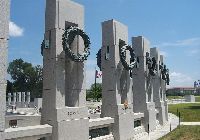
|
Someone from my home state put flowers on the California pylon.
|

|
.
|

|
.
|
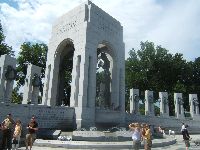
|
.
|

|
The pavillions can also be entered from outside the memorial.
|

|
The Pacific side is set up the same way as the Atlantic side. The bottom lists
campaigns and battles, the middle divides the theater up into general areas,
the sides interpret the war for us.
|

|
.
|

|
Inside the pavillions, eagles carry victory wreaths.
|

|
On the ground, we are reminded that we won on the sea, the land and the air.
|

|
At the "back" of the memorial, that is, on the other side of the fountain
pool from the sidewalk, on the side closest to the Lincoln memorial, between
the two arcs of state pylons, there is this bank of stars. There is one
star for every 100 Americans who died in the war.
|

|
.
|

|
Near the stars, the sacrifices of our allies are included as well.
|





















































